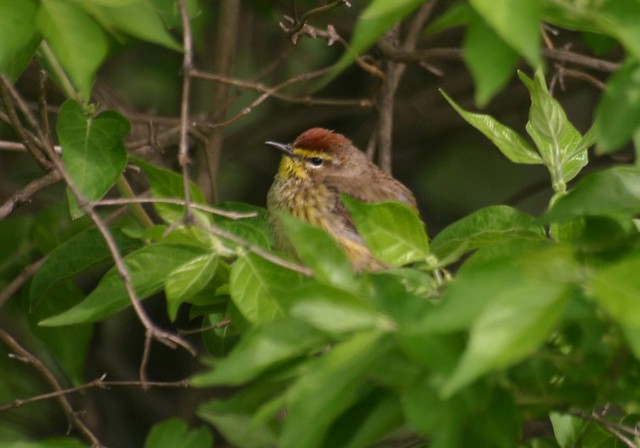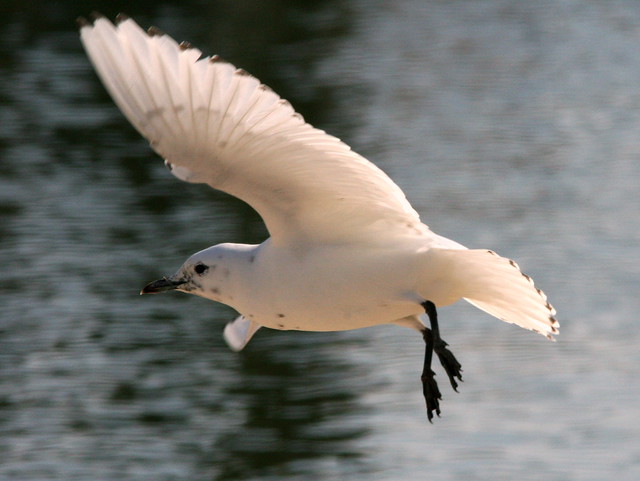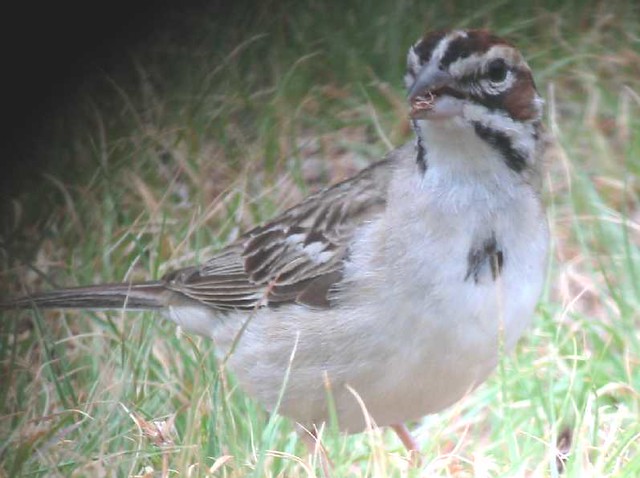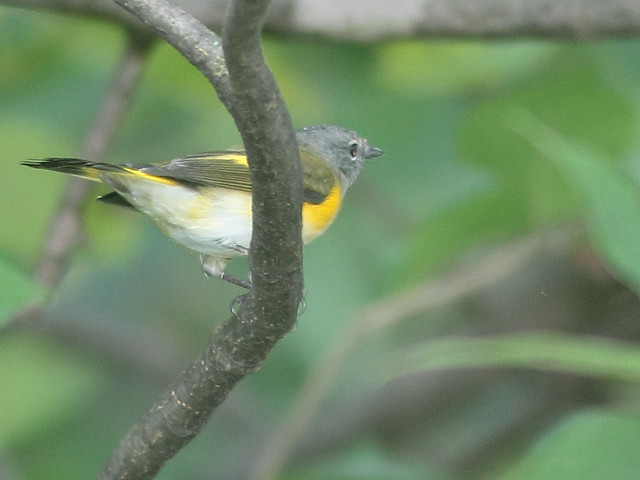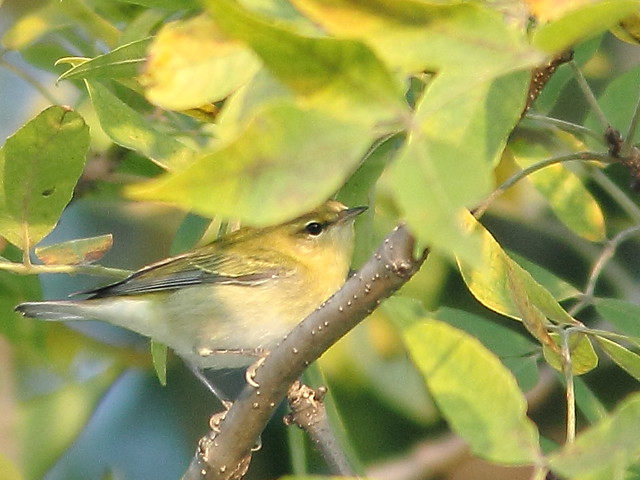Posted by: Ken @ 8:24 pm
This spring, warbler migration was painfully dull both in our part of south Florida and near our second home in northeastern Illinois. We departed for Illinois at the beginning of May, just when numbers of warblers had started building up there in previous years. Now that summer has arrived and it is a rainy day, all I can do is remember last year and look forward to fall migration.
The Prairie Warbler was quite common in Florida this spring, but we have never yet seen one in Illinois.
Some of the warblers we saw this spring both in Florida and in Illinois were…
Yellow-rumped Warbler (photographed in Illinois)
This Western subspecies of Palm Warbler, common in Florida, is the dull-colored form…
…as compared to this Eastern “Yellow” Palm Warbler, photographed in Illinois
Black-and-white Warbler (in Florida)
Yellow Warbler (in Illinois)
Now I’m remembering some warblers we had hoped to see– but didn’t see at all this spring, either in Florida or Illinois.
Past spring migrations in Florida, we have seen…
Black-throated Blue Warbler
Blackpoll Warbler
Northern Parula
During past spring migrations in Illinois we have gotten…
Bay-breasted Warbler
Here is another view of a Bay-breasted Warbler
Magnolia Warbler
Northern Waterthrush
Louisiana Waterthrush
Cape May Warbler
Black-throated Green Warbler
Blackburnian Warbler
American Redstart
This Nashville Warbler is actually flying– I accidentally caught him at an instant when his wings were closed
Posted by: Ken @ 9:23 am
Most of my posts attest to the fact that I do not range far and wide in search of rare or uncommon birds. It’s not that I lack interest in putting a few new notches in my birding belt. If an unusual bird is reported and it is reasonably nearby, I will make an effort to see it, but I’ve never been one to jump on a plane or drive overnight to join the “twitchers” who congregate in hopes of adding a new species to their life/year/locality lists.
Some of our “rare” bird sightings were incidental to trips we had taken for non-birding reasons. I think of the Piratic Flycatcher that showed up in Fort Sumner, New Mexico just as I was setting out to drive from Albuquerque to Amarillo to visit our son and his family. We diverted from I-40 and lost about an hour of travel time to see it. My digiscoped image of this vagrant from Mexico was taken with a little 2.4 megapixel point-and-shoot camera back in 2003, long before I acquired my first DSLR.
Then, in 2009 there was an Ivory Gull that appeared in Cape May, New Jersey, and was only seen during the week that we flew there for the funeral of my uncle.
In the spring of 2010 we picked up another life bird when local birders found a Ruff that showed up at Nelson Lake Marsh/Dick Young Forest Preserve near our Illinois condo. My photos of the sandpiper, seen here in the foreground, foraging with several Lesser Yellowlegs, were only good enough to document the larger Ruff’s “pot belly,” more upright posture, and drooping bill that set it apart. I must admit that we likely would not have located the bird, much less identified it, without the help of a couple of experts who happened to be there when we followed up on the report. It was my ABA Area Life Bird #572, and Mary Lou’s #505. As evidence of our slow progress to the coveted 600 mark, we now have only advanced to 581 and 509 species respectively.

This past May 15, while Mary Lou and I were birding Lippold Park in neighboring Batavia we saw three or four sparrows and two robins foraging on the trail some distance ahead. All but one of the sparrows were Song Sparrows, but one seemed longer and slimmer and walked instead of hopping. About all we could make out with the binoculars was a strong line over its eye that suggested it was a Lark Sparrow. I took several photos that confirmed its identity. According to eBird, this was the first of this species ever reported from Batavia or any of the neighboring Illinois communities in 10 or more years. Because of the distance, the quality of the photo is poor.
Lark Sparrows are more common in the Western states. Here is another bad shot of one on our lawn in New Mexico, digiscoped through the living room window about 10 years ago.
We watch the local sightings reports, and during the past two weeks we followed up, rather tardily, on a couple of interesting, if not rare, birds.
A Great Horned Owl with two youngsters had been seen roosting the the large oaks in nearby Fabyan Forest Preserve. They were still there despite our delay in searching for them, and they provided a nice photo opportunity.
The owlets were mostly obscured high in the foliage, but they did crane their necks to get a better look at us.
In the case of another recent report of a species that I had not yet photographed, it seems we waited too long after the first sighting. A pair of Red-headed Woodpeckers had been seen courting in an old tree only 3-4 miles from our home. For the past two mornings we spent over an hour observing the nest that the birds had excavated, but there was no sign of them. Perhaps the female was now incubating out of sight, or worse, they had been evicted by some of the European Starlings that were present in large flocks.
All I have to show for our efforts is a photo of their hole with a starling on a nearby branch. Of course we will be back and maybe can report better news about the couple. While a few starlings did roost on the tree, none entered the nest hole, so this may be a sign that the female woodpecker is sitting on eggs.
Our unsuccessful quest tor the Red-headed Woodpecker wasn’t just a “dry hole,” as there were other interesting wild creatures in the vicinity. This Barn Swallow struck a nice pose.
A noisy Eastern Towhee briefly emerged from a secluded perch.
This Red-winged Blackbird added color to the scene as, in song, it displayed its expanded epaulets.
Eastern Kingbirds were gathered in a nearby tree. This one was picking through the grass, probably looking for nest material.
A Killdeer eyed us suspiciously from the shore of the river.
This Chipmunk looks as if it could not stuff one more seed into its cheek pouches.
Eastern Cottontail Rabbits in Illinois appear long-legged and muscular in comparison to…
…the aquatic coastal Florida subspecies of cottontails, little short-eared and dark-furred bunnies known as Marsh Rabbits.
Alas, we are leaving our second home in northeastern Illinois to return to Florida, just at the start of warbler migration. Yesterday Kane County Audubon Society sponsored its monthly “Scope Day” at Nelson Lake/Dick Young Forest Preserve, only about a mile from our condo. Although I obtained not a single decent shot of any of the Common Yellowthroats, American Redstarts, Magnolia Warblers and Black-throated Green Warblers we sighted, the arduous 3 1/2 mile walk around the lake made for a most enjoyable morning. We logged over 60 species.
The group included a nice mix of experienced and casual local birders, as well as visitors from out of state. They gathered on the east viewing platform to scope out herons and ducks:
Here, some of the two dozen birders who showed up are zeroing in on a Sedge Wren that posed nicely in the tall grass (until I raised my camera):
The past three days have been hotter and more humid than back “home” in Florida. The day before “Scope Day” I braved the heat and scouted out the east side of Nelson Lake. There were relatively few migratory birds to be seen after about 8:30 AM. They probably were hiding in the cool shade
This Magnolia Warbler was a sweet find, though its photo is a bit out of focus:
As usual, an American Redstart made my job very difficult by refusing to sit in one spot for more than a nanosecond:
When migrants are few and far between, I can always turn to more familiar subjects, such as this Black-capped Chickadee:
Common as they may be, I have found it difficult to get decent shots of chickadees; here is one from a different perspective:
A Ruby-throated Hummingbird appeared briefly in my viewfinder:
A couple of days earlier I serendipitously obtained a better image when a hummer wandered into my field of view as I was photographing a flock of Tennessee Warblers at Les Arends Forest Preserve; note its long tongue:
This redstart eyed me briefly:
The Tennessee Warblers were nearly as uncooperative as the redstart had been. Here was my best shot of one, peering out from under a leaf:
The best I could obtain from this Nashville Warbler was a “butt shot,” which nicely illustrates the yellow undetail coverts and longer tail feathers that help distinguish it from the more numerous Tennessee Warblers when they mingle in the treetops:

Three of the flycatchers that I spotted the day before before Scope Day failed to show up for the wider audience. This is a Least Flycatcher…
… a shadow-marred Great Crested Flycatcher…
… and here is my fuzzy shot that documents my sighting of an Olive-sided Flycatcher:
Exactly one year earlier, I had captured a better view of the Olive-sided Flyactcher at the same location, one that exhibits its namesake dark “vest:”
White feathers may ruffle up on the rump of this species, providing another useful field mark:
Compensating for the absence of their flycatcher cousins, Scope Day participant saw many Eastern Wood-Pewees:
American Goldfinches were the most common land birds we saw on Scope Day:
The goldfinches were busy attending to their young. Earlier this week, at Lippold Park, I captured this female gathering thistles for her nest:
Unlike nearly all other songbirds, goldfinches do not feed insects to their young. Instead, the adults ingest seeds and regurgitate a protein-rich “milk” from their crop linings:
Audubon walks are not only about birds, and participants got to see some interesting insects, including this Praying Mantis…
…a close-up of a nectar-sipping Eastern Tiger Swallowtail…
…a pollen-gathering Carpenter Bee (told from a Bumblebee by its dark non-furry abdomen)…
…and a vivid male Common Whitetail dragonfly resting trailside:
Finally, as I arrived home, hot and dehydrated, I saw the family of Sandhill Cranes resting in the shade of a willow next to our condo; my presence put them on alert:
We have been enjoying remarkably fair Autumn weather at our second home in northeast Illinois. In between the obligations and joys of sharing time with family and friends, there has been time for at least one birding excursion nearly every day.
One interesting venture last week was with Kane County Audubon Society, to the Fermi National Accelerator Laboratory (Fermilab ). Located in Batavia near Chicago, Illinois, this is a US Department of Energy national laboratory specializing in high-energy particle physics. Fermilab is very birder-friendly, and there is a great variety of natural habitat on their extensive grounds. The official Fermilab web site has an interactive map with links to the various birding “hot spots” within the 6800 acre facility. Peter Kasper updates a current list of bird sightings that is worth watching, as many rarities have appeared there over the years.
We gathered at the famous “Red Barn,” and walked the area known as Village Lakes:
Lake Law is near the start of the trail. It harbored lots of migrating Canada Geese, a pair of Pied-billed Grebes, and a few Green-winged Teal and American Coots:
Two American Pipits along the shore of Lake Law tolerated our close approach:
We had hopes of seeing Harris’s Sparrows, which have appeared in the Chicago area during the past couple of weeks and have been sighted at Fermilab many times in past years. Although I carried my camera on the walk, I put it to little use, something that often happens when I am hiking with a group. Alone, I am free to linger and look for the best shots, but this is hard to do when trying to keep up with other birders. For example, I got great binocular views of an Orange-crowned Warbler, but did not even think of my camera until it had flown into a thicket, the signal for the group to move on. I also failed to obtain photos of Fox Sparrows that lurked in the hedges.
Also in Batavia, but nearer to home, at Nelson Lake/Dick Young Forest Preserve, I did get a good shot of the normally reclusive Fox Sparrow that Mary Lou spotted for me:
We also had better luck with Orange-crowned Warblers, finding them on three consecutive days at Nelson Lake and also this one at Jones Meadow Park in North Aurora, which was foraging with a single Ruby-crowned Kinglet in low vegetation. Note is characteristic broken eye-ring and yellow under the tail:
The Orange-crowned Warbler emerged into full light and plunged off its perch in pursuit of a green insect that looked like a Katydid:
Its free-fall ended with the successful capture of the insect:
Eastern Bluebirds had nested in Jones Meadow Park a couple of years ago, but none were there all summer until this past week, just about when we would expect this species to disappear on its southward migration:
We saw this bluebird at nearly the same location this past spring:

In contrast, a “snow bird,” an early arriving Dark-eyed Junco showed up on the same day. We have been seeing them for about a week, but this was the first I was able to photograph this fall:
White-throated Sparrows sang softly along the asphalt track at Jones Meadow. This is a tan-striped individual. Older field guides often identified these as immature or female birds, in contrast to the white-striped “adults,” but this color variation, usually also showing streaks on the breast, appears in adults of both sexes:
To illustrate the difference, here is a close-up of a white-striped bird that I photographed this past spring at nearby Lippold Park:
Song Sparrows also treated us to short bursts of song. This bird had a particularly reddish tinge to its plumage, initially making me think it was another Fox Sparrow. It reminded me of the southwestern subspecies that I often saw in New Mexico:
Nearby, another streaked sparrow, which I first thought to be a Song Sparrow with an unusually gray head, has the head pattern typical of Lincoln’s Sparrow, as Peter Kasper himself kindly pointed out:
The smaller Savannah Sparrow is shorter-tailed and often shows some yellow in front of its eyes:
INDEX TO ROSYFINCH RAMBLINGS ARCHIVES
This morning we got out early to Lippold Park, located on the east bank of the Fox River in Kane County, Illinois. The temperature was a brisk 58 degrees, but it quickly warmed up into the mid-60s. We hoped to see warblers, and we were not disappointed in their numbers, though the species mix was limited.
The river was quite placid, as we have not had much rain the past couple of weeks. This is the view looking across to the west bank:
At first it was very quiet, and we soon found out why. A Cooper’s Hawk was standing sentinel over the prairie from a riverside treetop:
A few minutes after the hawk’s departure, the small birds began appearing. A Gray Catbird was one of the first to poke its head out of the shrubs:
We have been seeing quite a few hummingbirds this week. There were at least four along the river bank, and I wasted quite a few megapixels trying to get an image of one. This was the best I could do:
The first warblers we saw were American Redstarts. No red and black adult males showed up, so we saw only “Yellow-starts.” All appeared to be immatures, judging by the lack of color in their wing coverts.
They darted about, flaring their tails to display the bright yellow patches.
Note the redstart’s typical drooped-wing posture:
We walked northward along the bank, the prairie on our right and stream-side trees and flower patches on our left. Many goldfinches were feeding on the seed heads. Among them we spotted a Nashville Warbler.
This is a female, which shows less yellow on its belly than the male. Both have gray heads, yellow throats and conspicuous white eye rings:
Then, we noticed several Tennessee Warblers foraging for insects in the flowers. As we approached, the warblers stayed in place after the goldfinches flew off. The warblers were very active and it was difficult to get a full body view of any of them.
This Tennessee Warbler hangs head-down, the better to find a juicy bug :
Though partially hidden, this Tennessee Warbler shows off its distinctive eye markings and white under its tail. The extensive white on its belly indicates that it is probably an adult female: 
One Tennessee Warbler flew directly towards me as I was taking its picture:
Scores of Cedar Waxwings settled in to attack an abundance of berries:
We were not able to pin down the identity of this little flycatcher. It is either a Willow or Alder Flycatcher, nearly identical in appearance and separable from each other by voice (click on the photo to see a close-up of its face and bill): 
Monarch butterflies are migrating through:
We saw a Magnolia Warbler, but it did not pose for its portrait. Yesterday morning, this one appeared at Nelson Lake:

This male American Goldfinch is molting into its somber winter uniform:
No threat to small birds, a Red-tailed Hawk floats lazily above:
















